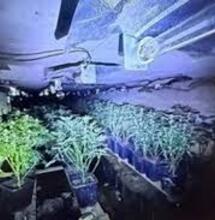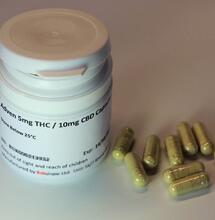Cracked Leaves

The leaves on my plants are cracking in half and developing light and brown spots. Overall leaves are light green and do not look healthy. What can I do? They're about 10 cm tall with 4 pairs of leaves.
The leaves on my plants are cracking in half and developing light and brown spots. Overall leaves are light green and do not look healthy. What can I do? They're about 10 cm tall with 4 pairs of leaves.
| Male pre-flowers develop 3-4 branch internodes from the top of the plant. Look for a small little nub that later turns into a pollen sack. |
The leaves on my plants are cracking in half and developing light and brown spots. Overall leaves are light green and do not look healthy. What can I do? They're about 10 cm tall with 4 pairs of leaves.
Malte
You have definitely got fertilizer/nutrient lockup. The problem has existed from the beginning, but it is only now that you recognize the problem because of the plants physical symptoms - discolored weak brittle leaves. In general this means that plants have suffered a general overdose of nutrients. The soil is packed with fertilizer salts (nutrients). Some of the nutrients are being taken up faster than others which causes uptake of some nutrients is blocked. I am not sure about the pH of your water. In Denmark, the pH ranges from below 6 to above 8. This could be your problem. It could also be the EC (electrical conductivity) or the concentration of nutrients already in the tap water. Since Denmark is surrounded by water and sodium and calcium are probably at high levels. Sodium, in levels above 50 PPM (parts per million) will block other nutrients from being drawn in by roots.
If your water is packed with nutrients such as sodium, chances are that you will need to run your water through a reverse osmosis device to remove the toxic nutrients. Once the water is clean, you can add the prescribed amount of fertilizer to make the nutrient solution. But, for the time being, you have to flush out the excess nutrients in pots. Flush out the nutrients by pouring 2-3 liters of water for every liter of soil in the container. An 11-liter container would require a flushing of at least 22 liters.
Here is a quick rundown on the macronutrients and symptoms of deficiency and toxicity.
Nitrogen is the most common nutrient deficiency. Symptoms include slower growth lower leaves become yellow between veins. Yellowing progresses through leaf before it drops off. Stems and leaf undersides may turn reddish-purple.
An overdose of nitrogen causes excessively lush foliage that is soft and susceptible to stress including insect and fungal attacks. Stems become weak and may fold over easily. The vascular transport tissue breaks down and water uptake is restricted. Roots develop slowly and rot easily.
Lack of phosphorous causes stunted growth. Leaves are smaller, bluish-green and often with blotches. Stems, leaf stems (petioles) and main veins turn reddish purple starting on leaf underside. Leaf tips of older leaves turn dark and curl downward. Leaves severely affected develop large purplish-black dead blotches and die. Flowering is often delayed and buds are uniformly smaller. Deficiencies are aggravated by clayey, acidic and soggy soil.
Deficiencies are most common when the pH of the growing medium is above 7 and phosphorus is unable to be absorbed properly. The soil is acidic (below 5.8) and/or there is an excess of iron and zinc. The soil has become fixated (chemically bound) with phosphates.
Excessive phosphorus interferes with calcium, copper, iron, magnesium and zinc stability and uptake. Toxic symptoms of phosphorous manifest as a deficiency of zinc, iron, magnesium, calcium and copper; zinc is the most common.
Potassium deficient plants often appear healthy, but soon older leaves, first tips and margins, followed by whole leaves turn dark yellow and die. Stems often become weak and sometimes brittle. Plants become susceptible to disease. Potassium is usually present in soil, but locked in by high salinity. A potassium deficiency causes the internal temperature of foliage to climb and protein cells burn or degrade. Evaporation is normally highest on leaf edges and that's where burning takes place.
Potassium toxicity is difficult to diagnose because it is mixed with the deficiency symptoms of other nutrients. Too much potassium impairs and slows the absorption of magnesium, manganese and sometimes zinc and iron. Look for signs of toxic potassium buildup when symptoms of magnesium, manganese, zinc and iron deficiencies appear.
Below are the suggested soluble salts fertilizer recommendations for indoor cannabis cultivation. Values expressed in parts per million.
Element Limits Average
Nitrogen 150 - 1000 250
Calcium 100 - 150 200
Magnesium 50 - 100 75
Phosphorus 50 - 100 80
Potassium 100 - 400 300
Sulfur 200 - 1000 400
Copper 0.1 - 0.5 0.5
Boron 0.5 - 5.0 1.0
Iron 2.0 - 10 5.0
Manganese 0.5 - 5.0 2.0
Molybdenum 0.01 - 0.05 0.02
Zinc 0.5 - 1.0 0.5



